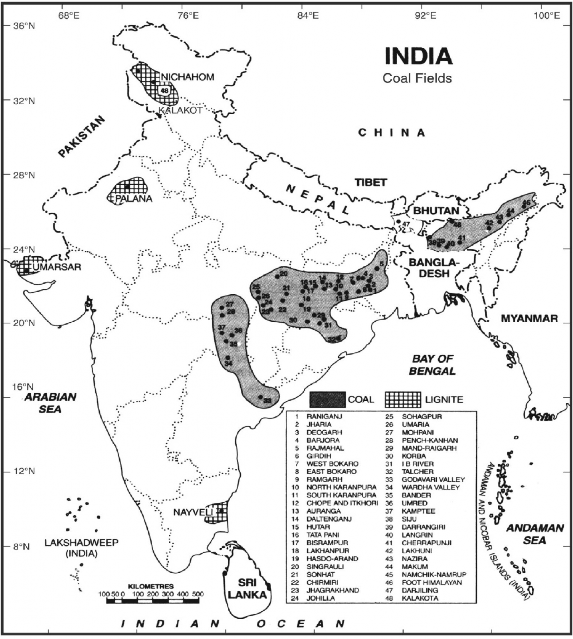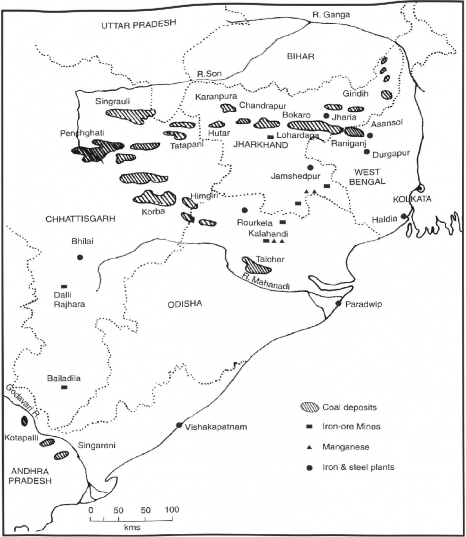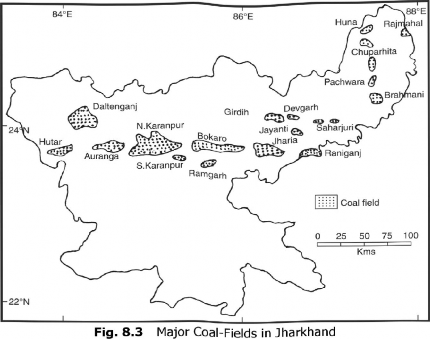Distribution
The distribution of coalfields has been shown in Fig. 8.1, while the state-wise coal reserves and their percentage share have been given in Table 8.1.
Table 8.1 Coal Reserves in India—2005-06
State | Total reserves in million tonnes | Percentage of all India reserves |
1. Jharkhand | 72,565 | 28.97 |
2. Odisha | 61,684 | 24.62 |
3. Chhattisgarh | 40,865 | 16.24 |
4. West Bengal | 27,495 | 10.98 |
5. Madhya Pradesh | 19,672 | 7.85 |
6. Andhra Pradesh | 17,595 | 7.06 |
7. Maharashtra | 8,635 | 3.45 |
{Contdl}

Fig. 8.1 Coal Fields
(Contd.)
8. Uttar Pradesh | 1,135 | 0.49 |
9. Meghalaya | 469 | 0.20 |
10. Assam | 385 | 0.15 |
11. Bihar | 178 | 0.07 |
12. Arunachal Pradesh | 95 | 0.02 |
13. Nagaland | 22 | 0.01 |
Total | 2.50,795 | 100.00 |
Source: Statistical Abstract of India, 2007.
The major states having large proportion of the coal reserves of the country are Jharkhand, Odisha, Chhattisgarh, West-Bengal, Madhya Pradesh and Andhra Pradesh (Fig. 8.2). A brief account of coal reserves in these states has been given in the following:
(i) Jharkhand The state of Jharkhand, accounting for about 29 per cent, has the first rank in coal reserves and its production. Most of the coal belongs to the Gondwana period. The districts of Dhanbad, Dumka, Ilazaribagh, and Palamu are very rich in coal deposits. The main coal mining centres are Auranga, Bokaro, Daltenganj, Dhanbad, Giridih, Hutar,Jharia, Karanpur, and Ramgarh (rig. 8.3).
(a) The Jharia Coalfield Out of all the coal mines of Jharkhand, Jharia is the largest and most important coal producing mine, which sprawls over an area of about 460 sq km. It contains the best metallurgical coal (bituminous). Nearly 90 per cent of the coking coal is produced from the Jharia mine. Its coal is mainly supplied to the iron and steel plants of Asansol, Bokaro, Durgapur, and Jamshedpur.
(b) The Bokaro Coalfield This coalfield stretches in the valley of Bokaro river in Hazaribagh district, about 32 km to the west of Jharia. The Kargali seam (37 metres) of the Bokaro coalfield is one of the thickest of the Gondwana period in (India). Its coal is mainly supplied to the iron and steel plant of Bokaro.
(c) The Giridih or Karharbari Coalfield The Giridih coalfield stretches in the district of Ilazaribagh. Its seams are very close to the surface. It provides one of the finest quality of bituminous coal used for the metallurgical industry. Its coal is supplied to the Bokaro and Jamshedpur steel plants.
(d) The Karanpur Coalfield The Karanpur coalfield is divisible into the North and the South Karanpur coalfields. It lies only about 30 km to the west of Bokaro. The thickness of its seam is about 25 metres. Much of the coal is, however, non coking.
(e) The Ramgarh Coalfield Stretching over an area of about 100 sq km, the Ramgarh coalfield is only about 9 km to the west of the Bokaro coalfield. The coal of Ramgarh is of relatively inferior quality containing a high proportion of ash (about 30%) and carbon 35 per cent.
(f) The Hutar Coalfield Stretching over about 200 sq km the Ilutar coalfield lies in the Palamau district. Its seams are however, thin and the coal is of inferior quality containing about 50 per cent carbon, 30 per cent volatile matter and 20 per cent ash.
(g) The Daltenganj Coalfield Sprawling over 55 sq km, this coalfield lies in the Palamau district. Its coal is either semi-anthracite or non-coking, of inferior quality which can not be used in metellaurgical industries.

Fig. 8.2 Gondwana Coal Deposits
(h) Deogarh Coalfields This coalfield lies in the Dumka district and stretches over an area of about 20 sq km. The coal is of inferior quality containing about 40 per cent carbon, 25 per cent volatile matter and 35 per cent ash content. Its coal is mainly used in the brick kilns.
(ii) Odisha The state of Odisha has more than 24 per cent of the total coal reserves and produces about 15 per cent of the total coal production of the country. In Odisha most of the coal deposits are found in Dhenkanal, Sambalpur, and Sundargarh districts.

(a) The Talcher Coalfield Stretching over Dhenkanal and Sambalpur districts, the Talcher coalfield covers an area of about 500 sq km. It has the second largest coal reserves in the country after Raniganj. The coal is, however, of lower grade containing only about 35 per cent of fixed carbon, 40 per cent volatile matter and about 25 per cent ash content. The coal is mainly utilised in the thermal power and fertiliser plants of Talcher.
(in) Chhattisgarh and Madhya Pradesh The state of Chhattisgarh has the third largest coal reserves (about 17 per cent of all India) in the country after Jharkhand and Odisha, but it holds the first rank in its production. Coal deposits are found in Bilaspur, Betul, Chhindwara, Narsinghpur, Raigarh, Rewa and Surguja districts. Singrauli, Sohagpur and Umaria (Rewa district), Bisrampur, Jhilmilli, Ramkola, Tattapani (Surguja district), Korba and Sandurgarh (Bilaspur district), Bench and Kanha valley (Chhindwara district), Mand river (Raigarh district), and Patakhera and Dulhara (Betul district) are the main mining centres of coal in Chhattisgarh.
(a) The Singrauli Coalfield Stretching over the Sidhi and Shahdol districts is the largest coalfield of Madhya Pradesh. Its Jhingurda coal seam with a thickness of 132 metres is the thickest coal-seam of the country. The coal belongs to the Gondwana period, which contains 40 to 50 per cent of fixed carbon. Its coal is mainly utilised in the thermal powerplant of Obra.
(b) The Korba Coalfield the Korba coalfield lies in the Bilaspur district Two of its coal seams are more than 30 metres. The coal is of average quality and is used mainly in the Korba thermal power plant.
(c) The Pech-Kanha-Tawa Coalfield It lies in the Chhindwara district. In quality its coal is of coking and semi-coking category.
(d) Umaria Coalfield Tills coalfield lies about 60 km south of Katni. The coal contains a higher percentage of ash and moisture. It is used mainly in the generation of thermal power. In addition to these, coal is also mined at Jhilmili, Sonahat, and Tattapani coalfields of Suiguja district.
(iv) West Bengal West Bengal has about 11 per cent of the total coal reserves of India (Table 8.1). The coal deposits of West Bengal lie in Bankura, Bardhman, Birbhum, Darjeeling, Jalpaiguri, and Puruliya districts. The most important of coal reserves and mining coalfield of West Bengal is Raniganj.
(a) Raniganj Coalfield Stretching over 185 sq km in the Bardhman and Birbhum district to the north-west of Kolkata, it is the most important coalfield of West Bengal. It is known for the good quality of coking coal. It contains 50 to 65 per cent of carbon. It is used in the metallurgical industry, especially in the Durgapur iron and steel plant.
(b) The Darjeeling Coalfield The coal of Darjeeling district belongs to the Tertiary Period. It is exposed in the Mana and Mahanadi valleys. The coal is in powder form with coking quality.
(v) Madhya Pradesh About 8 per cent of the coal reserves of India are found in Madhya Pradesh. The main coal deposits lie at Singrauli, Muhpani, Satpura, Sohagpur and Pench Kanhan.
(vi) Andhra Pradesh About 7 per cent of the coal reserves of India are found in Andhra Pradesh. Its main coal deposits are found in the Godavari valley. The districts of Adilabad, Khammam, Nellore and Warangal are known for its production. Coal is mainly used in thermal power plants of Kottagudem, Nellore, Ramagundam, Errazada, Husain-Sagar, and the fertiliser plant at Ramagundam.
The Singareni coalfield lying about 185 km to the east of Hyderabad is the main mining area of coal in Andhra Pradesh. Another important coal producing centre is at Kottagudam. Its coal seam is of about 18 metres and the coal is of good quality.
(vi) Maharashtra The main coal deposits of Maharashtra lie in the Wardha valley, stretching over the Nagpur (Kampte-coalfield), and Yavatmal districts. The coal from these coalfields is utilised by the railways and the thermal power stations of Trombay, Chola (Kalyan), Khaperkheda, Paras, Ballarshah, Nasik and Koradi.
